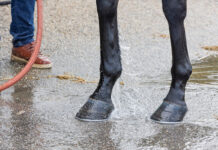Information about laminitis in horses advances all the time, but the reality of this crippling and life-threatening disease remains the same: Living in pain with deformed hooves cripples the laminitic horse while stress, worry and bills cripple the owners.
What you have seen of this too-common disease has probably shocked you. You’ve watched owners soaking and bandaging and gingerly hand-walking their stiff-legged, laminitic horses. You’ve seen hooves crusted with growth rings, scarred by abscesses, and shod with pricey designer horseshoes or boots.

Every horse is at risk of laminitis. It’s a disease with different forms, multiple causes, varying severity, and an impact like no other. Some horses recover to gallop again, some spend months on stall rest, and others live with low-grade chronic lameness, helped by a special diet, conscientious hoof trimming and medication for the rest of their lives.
For advice, we turned to a respected source on the subject. The Animal Health Foundation (AHF) funds laminitis research all over the world. The charity’s founder, Donald Walsh, DVM, is optimistic about how horse owners can prevent and manage the disease.
What is Laminitis?
Most people think laminitis is a horse foot disease, but it is more than that. The AHF defines laminitis as the breakdown of the internal supporting structures (“laminae”) between the outer hoof wall and the coffin bone inside the hoof. This breakdown can also damage the delicate circulation in the horse’s foot and cause great pain.
Laminitis commonly affects horses’ feet when hormone production is disrupted, but it is also caused by retained placentas in mares after foaling, or when an injured horse bears weight excessively on its good foot. Body-wide inflammation, such as a complication after surgery, severe diarrhea, or diseases like Potomac horse fever are other pathways. Horses may also develop laminitis when exposed to stable bedding made from black walnut trees.

The most classic laminitis is direct carbohydrate overload, caused when a horse gorges on grain. He may not look sick, but his feet can be damaged by a situation that could have been prevented.
Laminitis research focuses on any one of these causes of the disease. Researchers look at aged horses at risk for the hormonal disease pituitary pars intermedia dysfunction (PPID, or Cushing’s disease), which alters pituitary hormones. They also research how efficiently horses regulate the hormone insulin, how they handle stress, or how seasonal or gender-related hormones affect them.
The most familiar form of laminitis is the sore-footed aftermath of grazing on rich spring grass. Many of these horses have what is called equine metabolic syndrome, rooted in insulin dysregulation, and frequently are overweight with obvious cresty necks or fatty areas around the tail base, sheath and shoulders.
Laminitis Fast Facts◆ Laminitis is a breakdown in the interior supportive structures of the horse’s hoof. ◆ One of the most common causes of laminitis is over-consumption of high-sugar feeds or spring grass, but there are many potential causes. ◆ Founder is a serious, crippling, and painful condition that can occur when the structures of a hoof are damaged by laminitis. |
Signs of Laminitis in Horses
Laminitic horses are usually lame in both front feet and sometimes in all four feet. Laminitic horses take shorter, more tentative steps than usual, and will toss their heads when turning at the end of a walkway. They may stand with their hind feet tucked forward under their bellies, and their front feet strutted out in front.
But laminitis caused by hormonal problems may have been sending you warning signals for months by gradually altering the shape of the horse’s feet. Hoof wall ridges are common, but the Animal Health Foundation suggests that it is farriers who see it first; they will remark that the sole is flattening out or bruised, and that the white line around the border of the sole is stretching and flecked with hemorrhage even if the horse isn’t noticeably lame.
The Mechanics of Laminitis
When the inner lamina tissue are damaged by laminitis, the bone partially detaches from the hoof wall. If you’ve ever torn one of your fingernails loose, you know how much damaged lamina hurt. Now imagine bearing your weight on that ripped nail: That’s how a horse feels when standing on laminitic hooves.
Sometimes the lamina are mildly damaged; other times the damage is focused on a portion of the foot. Commonly, the toe region is the worst affected. In severe cases, the bone becomes unstable inside the foot.
According to AHF, founder is the painful, crippling result of a foot’s bond damaged by laminitis. When a horse founders, the unstable coffin bone rotates or even sinks, putting pressure on the sole of the foot, sometimes even puncturing it.
Veterinarians take X-rays to evaluate the rotation factor, and also may take a venogram to get a picture of how badly the circulation is damaged.
What can you do to reduce your horse’s risk of laminitis or founder, and what makes a laminitis emergency? Click here to continue reading about treating laminitis.
This article originally appeared in the April 2019 issue of Horse Illustrated magazine. Click here to subscribe!






